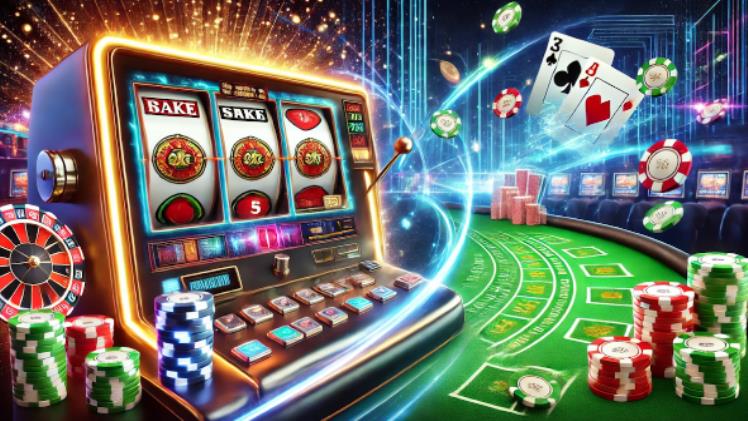The appeal of casual slot play: relaxation and fun
Casual slot play offers a comforting retreat from life’s hustle and bustle. Picture this: you’ve just come home after a long day, kicked back in your favorite chair, and launched a whimsical slot game. In front of you spins a carousel of symbols—bright, animated, playful. Every spin is a stress-reliever, a short escape. No complex decisions, just pure entertainment.
Why players choose casual slots for entertainment
Many players turn to slots Judi Slot precisely because these games require no prior knowledge or strategy. They aren’t scouting for edge or analyzing volatility charts. They want immediate enjoyment. Casual slots feature intuitive interfaces and friendly tutorials: set your bet, hit spin, and watch symbols align. It’s akin to opening a lighthearted episode of your favorite sitcom: easy, relaxing, and enjoyable.
Popular features like free spins, mini-games, and themed slots
Casual slots often shine through novelty and fun rather than big risk. Features like free spins—triggered by scatter symbols—let players enjoy rounds without spending more money. Mini-games within slots offer light engagement—a simple pick-and-click bonus or a memory match where wins build gradually. And themed visuals, whether based on fairy tales, beloved film franchises, or fantasy worlds, provide narrative depth that’s more entertainment than gambling.
There’s also a social dimension: many casual slots include daily bonuses, gift-sharing features, or light interaction via chat. That communal aspect amplifies the sense of shared leisure.
Competitive slot gaming: high stakes and big wins
The flip side of casual play reveals the heart-thumping, risk-embracing realm of competitive slot gaming. Here, players are not just spinning reels—they’re pursuing massive jackpots, fear-induced adrenaline, and glories on virtual leaderboards.
High-volatility slots and progressive jackpots
High-volatility slots are the heart of competitive play. While wins are few, when they do occur, they’re massive. Consider progressive jackpot games like Mega Moolah or Mega Fortune—some have awarded prizes exceeding hundreds of millions, cementing their legendary status.
To choose high-volatility games, savvy players consider Return to Player (RTP) values. A slot offering 95% RTP but high volatility might reward once every few hundred spins—but when it hits, the payout is substantial.
Tournaments, leaderboards, and skill-based elements
Modern gambling platforms often host tournaments—spin-offs with scoreboards. Examples include:
- Time-limited sessions: earn as much as possible during a 5-minute bonus spin run.
- Point-based challenges: accumulate the highest spin profit among 100 participants.
- Skill-enhanced mini-games: insert quick puzzles into bonus rounds where player decisions affect winnings.
Though outcomes remain random, these structures inject a sense of strategy and planning. Players weigh bet sizes, timing, and bonus choices—turning slots into a hybrid experience of luck and subtle skill.
Player motivations: different goals, different experiences
It’s illuminating to examine why people gravitate toward either casual or competitive slot play. Mentalities diverge significantly.
Casual players: enjoyment, relaxation, and escapism
Casual gamers usually view slots as fun, short-term diversions. Their motives include:
- Escaping stress: spinning after work to unwind.
- Immersive diversion: appreciating themed sounds and stories.
- Controlled enjoyment: because bets are small, play is guilt- and worry-free.
Their experience is user-focused: they want simplicity, fun, and mild surprises.
Competitive players: thrill of risk, strategy, and chasing rewards
Competitive players seek:
- Adrenaline surges: the intensity of high stakes.
- Prize acquisition: from large jackpots to bonus prizes.
- Strategic depth: choosing volatility settings, betting tactics, and timing tournament entries.
These players often track RTP stats, volatility ratings, and community feedback to maximize their edge—a calculated approach within chance.
How game design caters to both approaches
Game designers build layers into slots catering to both audiences. A slot launches with casual mechanics—easy auto-play, conservative bet ranges, and engaging themes. But hidden toggles may offer high-RTP modes, bonus-buy paths, and tournament entry options. Autoplay remains for casual play, though bonus modes may hint at competitive potential if a player shifts their intentions.
This dual approach widens appeal and increases retention—players can migrate seamlessly from casual fun to competitive intensity, depending on mood.
Game design: how slots cater to both audiences
By examining design components, one sees how slots attract both casual and competitive players, often within the same product.
Casual-friendly mechanics (autoplay, simple rules)
- Autoplay relieves players from clicking repeatedly.
- Low minimum bets allow extended play on modest budgets.
- Simple UI ensures instant understanding and engagement.
- Relaxed soundscapes use ambient effects and calming melodies to soothe.
These elements remove friction—no learning curve, immediate gratification.
Competitive elements (bonus buys, high RTP modes)
- Bonus-buy features let players skip directly to feature rounds—time-saving and high-risk.
- RTP toggles let players choose higher volatility or return paths.
- Time-limited events and leaderboard modes add competitive tension.
These features empower players to tip the scale in sessions where intensity is desired.
The role of visuals and sound in each style
Casual slots use pastel colors, smooth animations, and friendly characters. Sounds are pleasant; design aims to comfort. Competitive slots, meanwhile, deploy sharper visuals—flashing lights, spin counters, countdown clocks—paired with high-BPM audio to heighten excitement and urgency.
Bankroll and risk: how play styles affect spending
Player spending behavior reflects their approach. Casual or competitive—it makes a difference.
Managing losses and setting limits for each style
Responsible design helps:
- Deposit limits: prevent overspending.
- Loss caps: maximum daily/session losses.
- Reality reminders: time warnings, self-exclusion options.
- Cooldown periods: especially after significant losses.
Community and social aspects: playing alone or for glory
Online slots are not just isolated spins—they’re social experiences, albeit in different ways.
Social slots (sharing wins, gifting features)
Casual platforms often allow:
- Sharing “I won!” messages via friends lists.
- Sending free spins to peers as gifts.
- Light chat options during free-spin sessions.
These features foster friendly interactivity—players form loose communities, celebrating one another’s little wins.
Competitive communities (streamers, forums, tournaments)
On the other hand:
- Live streams of big-spin action (Twitch, YouTube).
- Reddit threads boasting spin stats and strategies.
- Tournament hubs where players follow leaderboards.
Gamers discuss volatility tactics, payout odds, and bankroll strategies. Some even collaborate—join syndicates hoping collective play triggers progressive bonuses.
How interaction differs between the two styles
Casual players appreciate camaraderie and social involvement—chatting or passing small bonuses. Competitive players invest in leaderboards, collective achievements, reputation, and aspirational content. Both build community, but the tone and depth differ.
The future of online slots: blending casual and competitive
As the industry evolves, the line between casual and competitive will continue to blur. Hybrid models are emerging.
Emerging trends (gamification, hybrid mechanics)
- XP systems: accumulate levels through spins, unlocking cosmetic rewards and bonus opportunities.
- Dual leaderboards: track “most spins” (for casuals) and “biggest wins” (for competitiors).
- Skill-enhanced bonus rounds: puzzle-solving decisions that affect payouts.
- Personalization: algorithmic recommendations tuned to player style—relaxed or intense.
These approaches aim to follow players’ moods—allowing them to be mellow or competitive within the same slot.
Predictions for evolving player preferences
- AI-curated experiences: recommend tailored sessions—relax, press, and play; or dive into the challenge.
- VR and social lobbies: communal lounges for casual players, competitive arenas for tournament participants.
- Blended events: daily leaderboards with tiers—casual (most spins) and competitive (biggest earnings).
- Streamer integration: integrated social channels where big winners and casual tipsters both shine.
Casual and competitive online slot Slot Gacor play offer distinct but overlapping experiences. Casual players seek solace: easy-to-understand gameplay, low risk, no pressure. Competitive players chase edge: high stakes, strategic modes, community recognition. Thankfully, the industry is recognizing that many players don’t want to choose one side—they want fluid experiences that adjust to mood, budget, and aspirations.
By weaving together relaxing visuals and immersive bonus rounds with leaderboard events and volatility choices, modern slots aim to create both solace and spectacle. Whether you’re looking to unwind after a long day or chase that next big win, today’s slots can meet you where you are.








Leave a Comment